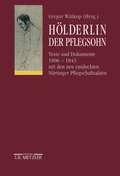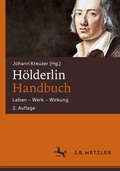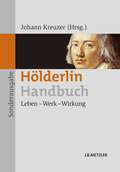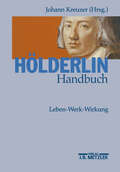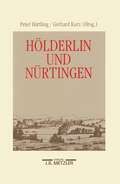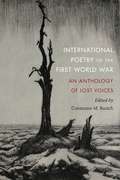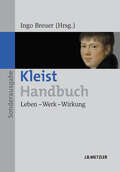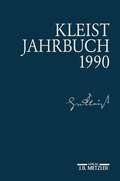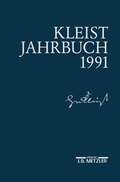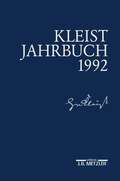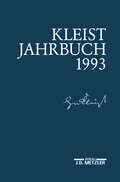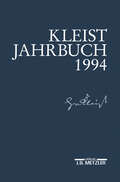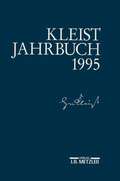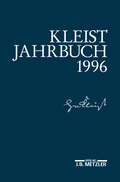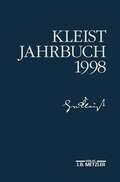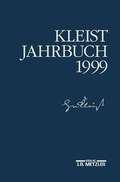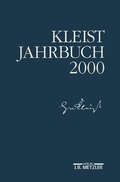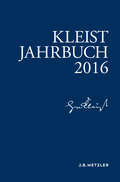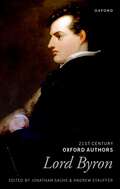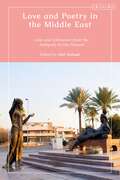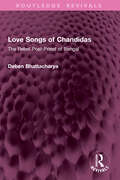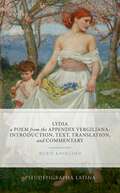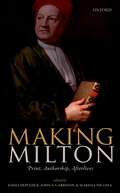- Table View
- List View
Hölderlin. Der Pflegsohn: Texte und Dokumente 1806-1843 mit den neu entdeckten Nürtinger Pflegschaftsakten. Schriften der Hölderlin-Gesellschaft, Band 16
Hölderlin-Handbuch: Leben ‒ Werk ‒ Wirkung
Nur wenige deutsche Dichter erfahren eine ähnlich starke Aufmerksamkeit bis in die jüngste Gegenwart wie Friedrich Hölderlin. Das Handbuch, seit vielen Jahren das Standardwerk zur Hölderlin-Forschung, informiert in der Neuauflage detailliert über den aktuellen Forschungs- und Wissensstand. Es analysiert das gesamte Werk des Dichters und behandelt darüber hinaus die Biographie im Kontext der Epoche, die Voraussetzungen für das Werk, die Poetologie und schließlich die Rezeption Hölderlins. So werden verschiedene Zugangsweisen und die Vielfalt der Denkmotive Hölderlins transparent. In der zweiten Auflage wurden zahlreiche Artikel neu verfasst und ergänzt.
Hölderlin-Handbuch: Leben – Werk – Wirkung
Hölderlin in allen Facetten. Nur wenige deutsche Dichter erfahren eine ähnlich starke Aufmerksamkeit bis in die jüngste Gegenwart. Das Handbuch informiert detailliert über den aktuellen Forschungs- und Wissensstand. Es behandelt die Biografie im Kontext der Epoche, Voraussetzungen für das Werk, Quellen und Poetologie. Sämtliche Werke von den frühen Hymnen über Hyperion bis zu den großen Elegien und Gesängen werden analysiert. So werden verschiedene Zugangsweisen und die Vielfalt der Denkmotive Hölderlins transparent.
Hölderlin-Handbuch: Leben - Werk - Wirkung
Das Handbuch informiert detailliert und kenntnisreich über den Forschungs- und Wissensstand zu Hölderlin: Biografie im Kontext der Epoche, Voraussetzungen und Quellen des Werks, Poetologie, Analysen des gesamten Werks - von den frühen Hymnen über Hyperion bis zu den 'großen' Elegien und Gesängen - Rezeptionsgeschichte, Nachwirkungen in Literatur, Musik und bildender Kunst, Zeittafel, Bibliografie und Register. Die verschiedenen Zugangsweisen zu Hölderlins Werk und die Vielfalt der Denkmotive, die von ihm ausgehen, werden transparent gemacht.
Hollow Palaces: An Anthology of Modern Country House Poems
The ‘country house poem’ was born in the seventeenth century as a fruitful way of flattering potential patrons. But the genre’s popularity faded – ironically, just as ‘country house society’ was emerging. It was only when the power and influence of the landed classes had all but ebbed away that poets returned to the theme, attracted perhaps by the buildings’ irresistible dereliction, but equally by their often very personal histories. This is the first complete anthology of modern country house poems, and it shows just how far (as Simon Jenkins points out in his Foreword) poems can ‘penetrate the souls of buildings’. Over 160 distinguished poets representing a diversity of class, race, gender, and generation offer fascinating perspectives on stately exteriors and interiors, gardens both wild and cultivated, crumbling ruins and the extraordinary secrets they hide. There are voices of all kinds, whether it’s Edith Sitwell recreating her childhood, W. B. Yeats and Wendy Cope pondering Lissadell, or Simon Armitage’s labourer confronting the Lady who’s ‘got the lot’. We hear from noble landowners and loyal (or rebellious) servants, and from many an inquisitive day-tripper. The book’s dominant note is elegiac, yet comedy, satire, even strains of Gothic can be heard among these potent reflections. Hollow Palaces reminds us how poets can often be the most perceptive of guides to radical changes in society. The book is illustrated by Rosie Greening.
International Poetry of the First World War: An Anthology of Lost Voices
Ranging far beyond the traditional canon, this ground-breaking anthology casts a vivid new light on poetic responses to the First World War. Bringing together poems by soldiers and non-combatants, patriots and dissenters, and from all sides of the conflict across the world, International Poetry of the First World War reveals the crucial public role that poetry played in shaping responses to and the legacies of the conflict. Across over 150 poems, this anthology explores such topics as the following: · Life at the Front · Psychological trauma · Noncombatants and the home front · Rationalising the war · Remembering the dead · Peace and the aftermath of the war With contextual notes throughout, the book includes poems written by authors from America, Australia, Austria-Hungary, Belgium, Canada, France, Germany, Great Britain, India, Ireland, Italy, New Zealand, Russia, and South Africa.
Keats’s Negative Capability: New Origins and Afterlives (Romantic Reconfigurations: Studies in Literature and Culture 1780-1850 #6)
In late December 1817, when attempting to name “what quality went to form a Man of Achievement especially in Literature,” John Keats coined the term “negative capability,” which he glossed as “being in uncertainties, Mysteries, doubts, without any irritable reaching after fact & reason.” Since then negative capability has continued to shape assessments of and responses to Keats’s work, while also surfacing in other contexts ranging from contemporary poetry to punk rock. The essays collected in this volume, taken as a whole, account for some of the history of negative capability, and propose new models and directions for its future in scholarly and popular discourse. The book does not propose a particular understanding of negative capability from among the many options (radical empathy, annihilation of self, philosophical skepticism, celebration of ambiguity) as the final word on the topic; rather, the book accounts for the multidimensionality of negative capability. Essays treat negative capability’s relation to topics including the Christmas pantomime, psychoanalysis, Zen Buddhism, nineteenth-century medicine, and Philip Pullman’s His Dark Materials trilogy. Describing the “poetical Character” Keats notes that “it enjoys light and shade; it lives in gusto, be it foul or fair, high or low, rich or poor, mean or elevated.” This book, too, revels in such multiplicity.
Kleist-Handbuch: Leben – Werk – Wirkung
Auf den Spuren Kleists. Er fasziniert nicht nur durch seine rätselhafte Persönlichkeit auch Kleists Werke entfachen oftmals Kontroversen. Immer wieder werden sie zum Prüfstein neuer wissenschaftlicher Fragestellungen. Das Handbuch bündelt die komplexe Forschungslage und präsentiert Leben, Werk und Wirkung. Weitere Kapitel informieren über Themen und Diskurse, mit denen sich Kleist auseinandergesetzt hat. Fundiertes Grundwissen und nützliche Anregungen für eine umfassende Beschäftigung mit Heinrich von Kleist.
Kleist-Jahrbuch 1998 (Kleist-Jahrbuch)
Das Kleist-Jahrbuch 1998 erscheint erstmals unter neuer Herausgeberschaft: Günter Blamberger zeichnet für den Abhandlungsteil, Sabine Doering und Klaus Müller-Salget sind für den Rezensionsteil verantwortlich. Im Zentrum jedes Jahrgangs stehen wie bisher die Abhandlungen. Für 1998 sind u.a. Beiträge vorgesehen von Andreas Kablitz (Kleists Robert Guiscard" im Spiegel frühneuzeitlicher Konzepte des Tragischen), Bernhard Dotzler ("Federkrieg". Kleist und die Autorschaft des Produzenten), Hansjörg Bay ("Als die Schwarzen die Weißen ermordeten". Nachbeben einer Erschütterung des europäischen Diskurses in Kleists "Die Verlobung in St. Domingo"), Michel Chaouli (Devouring Metaphor: Disgust and Taste in Kleists "Penthesilea"), Bernhard Greiner (Wende zur Kunst und Engführung ihres Versprechens: Kleists Schaffen im Horizont der Kantischen Philosophie, am Beispiel des "Robert Guiscard"), Wolfgang Riedel (Kleists "moralische Erzählungen" und die Anthropologie um 1800), Helmut J. Schneider (Zu Kleists Anekdoten und dem anekdotischen Prinzip seiner poetischen Welt) und Ulf Abraham (Kanondebatten am Beispiel Kleists). Seit Jahrgang 1990 beim Verlag J.B. Metzler. Die Bände erscheinen in jährlicher Folge. Sie können zur Fortsetzung bezogen werden.
Kleist-Jahrbuch 1999 (Kleist-Jahrbuch)
Unter dem Titel »Kleists Duelle« behandelte die internationale Jahrestagung der Heinrich-von-Kleist-Gesellschaft im Juni 1998 in Hamburg vielfältige Aspekte von Kleists Streitkultur.
Kleist-Jahrbuch 2000 (Kleist-Jahrbuch)
Das diesjährige Kleist-Jahrbuch widmet sich schwerpunktmäßig dem Rahmenthema Kleist und die Weltliteratur", u.a. mit Beiträgen von Anthony Stephens (Melbourne), Wolfgang Pircher (Wien) zu "Vergeltung Recht und Politik bei Kleist", Christian Moser (Bonn) zu "Fallgeschichten bei Kleist und Montaigne", Claudia Liebrand Köln) zu Kleists Re-Lektüren von Boccaccios Novellen, Walburga Hülk-Althoff (Siegen) über Kleist und Flaubert sowie Ingo Breuer Köln) zur Tradition der Novelle. Des weiteren enthält der Band die Abteilung "Abhandlungen", u.a. mit einem Beitrag von Michael Wetzel (Kassel), sowie einen umfangreichen Rezensionsteil."
Kleist-Jahrbuch 2016
Das aktuelle Jahrbuch dokumentiert die Verleihung des Kleist-Preises 2015 mit den Reden der Preisträgerin Monika Rinck, der Vertrauensperson der Jury Heinrich Detering und des Präsidenten der Heinrich-von-Kleist-Gesellschaft Günter Blamberger. Darüber hinaus enthält das Jahrbuch Beiträge zu Kleists Werken und Rezensionen wissenschaftlicher Neuerscheinungen zu Kleist.
Lord Byron: Selected Writings (21st-Century Oxford Authors)
This volume in the 21st Century Oxford Authors series offers readers a generous selection of the poetry upon which Byron's fame depended and his reputation now rests. It presents the poems in the chronological order in which they were published, working in almost every case from their first appearances in print. The Selected Writings include the entirety of Byron's two best-known works, Childe Harold's Pilgrimage and Don Juan, but the decision to work book-by-book means that they are presented not as unified works but as evolving serial publications, interspersed with other works published between installments or sequels. Alongside these two major works, wider representation is given to Byron's lyric poetry than has been typical in modern editions. Furthermore, in keeping with the 21st Century Oxford Authors series, the works are reproduced in something close to their original printed forms. Prioritizing the event of publication over that of composition, this volume offers a version of Byron close to how he would have been known to his original public. With extensive annotations, it emphasizes the social processes by which literary works come to exist in the world, particularly their publication and reception histories. The result is a fresh view of Byron's literary achievement and an impetus to further reading in the works of this extraordinary creative figure.
Love and Poetry in the Middle East: Love and Literature from Antiquity to the Present
Love has been an important trope in the literature of the region we now call the Middle East, from ancient times to modern. This book analyses love poetry in various ancient and contemporary languages of the Middle East, including Akkadian, ancient Egyptian, Classical and Modern Standard Arabic, Persian, Hebrew, Turkish and Kurdish, including literary materials that have been discovered and highlighted for the first time. Together, the chapters reflect and explore the discursive evolution of the theme of love, and the sensibilities, styles and techniques used to convey it. They chart the way in which poems in ancient poetry give way to complex and varied reflections of human sentiments in the medieval languages and on to the modern period which in turn reflects the complexities and nuances of present times. Offering a snapshot of the diverse literary languages and their relationship to the theme of love, the book will be of interest to scholars of Near and Middle Eastern Literature and Culture.
Love Songs of Chandidas: The Rebel Poet-Priest of Bengal (Routledge Revivals)
First published in 1967, Love Songs of Chandidās provides an informative introduction which makes vividly clear the importance of Chandidās to the Indian peasant masses. As the author tells us, the traveller through the Birbhum area of Bengal hears Chandidās everywhere, in the villages, in the fields, on the roads. Night after night, the people gather in the temple courtyards or on the village greens to listen to professional ‘Kirtan’ singers sing his songs of the divine love of Radha and Krishna. The influence of Chandidās on contemporary Bengali literature is equally important, his songs having enriched the work of great poets such as Rabindranath Tagore, Govindadas, and many others. The author also discusses the interesting topic of the Sahaja (‘spontaneity’) movement in Indian faith and literature, as manifested in the songs of Chandidās, and the worship of love-making, divine and human, as an important aspect of this faith. This book will be of interest to students of literature, music, history, cultural studies and South Asian studies.
Lydia, a Poem from the Appendix Vergiliana: Introduction, Text, Translation, and Commentary (Pseudepigrapha Latina)
This volume offers the first comprehensive literary and philological commentary on the Lydia, in any language. At its core is a freshly edited Latin text of the poem, which systematically reconsiders the paradosis as well as earlier textual scholarship and endorses numerous improvements against current editions. Besides scrutinizing all the textual problems and adopted solutions, the commentary provides a thorough linguistic exegesis of the text as well as a wide-ranging discussion of the poem's rich intertextuality, both Latin and Greek. The Lydia's literary side is also the main focus in the introduction, which challenges the established communis opinio that views the Lydia as a dateless anonymous imitation of Virgilian bucolic, by situating it in the literary context of the Late Republic: it highlights, for the first time, the centrality of Greek bucolic, in particular of Bion's Lament for Adonis and the anonymous Lament for Bion, in the Lydia's literary genealogy and tentatively revives the old attribution to Valerius Cato, as well as exploring the poem's relationship with its better-known sibling, the Dirae. The work is complete with an English translation, aimed to serve as a guide to the Latin text for readers without a solid background in the ancient language.
Making Milton: Print, Authorship, Afterlives
This volume consists of fourteen original essays that showcase the latest thinking about John Milton's emergence as a popular and canonical author. Contributors consider how Milton positioned himself in relation to the book trade, contemporaneous thinkers, and intellectual movements, as well as how his works have been positioned since their first publication. The individual chapters assess Milton's reception by exploring how his authorial persona was shaped by the modes of writing in which he chose to express himself, the material forms in which his works circulated, and the ways in which his texts were re-appropriated by later writers. The Milton that emerges is one who actively fashioned his reputation by carefully selecting his modes of writing, his language of composition, and the stationers with whom he collaborated. Throughout the volume, contributors also demonstrate the profound impact Milton and his works have had on the careers of a variety of agents, from publishers, booksellers, and fellow writers to colonizers in Mexico and South America.
